The village had three schools over the period 1851 – 1980:-
- National (Church of England) School (1851 – 1908)
- Public Elementary School or Council School (1909 – 1924)
- 10/5/1909 Opening of the tin school
- 27/9/1909 New head
- 25/10/1909 Royal visit
- 23/11/1909 School Inspector’s report
- 23/11/1910 – Inspector’s Report
- 24/7/1911 – Labour Exam
- 15/11/1911 Inspector’s Report
- April 1913 – Diphtheria
- 31/3/1915 Parish Meeting
- December 1917 More heating problems
- 11/1/1918 School buildings inspection
- 7/3/1924 More problems with heating
- 9/5/1924 Closure of the tin school
- County Primary School (1924 – 1980)
- 9/3/1920 Education Committee resolves to build a new school
- 12/5/1924 New school opens
- 13/5/1924 Formal opening of the new school
- 1925 – Scarlet fever
- 4/9/1939 Outbreak of War
- 10/9/1939 Evacuees arrive
- 12/10/1942 New headteacher
- 1/5/1951 New Infants teacher
- 5/2/1952 – Report by HM Inspectors
- 25/7/1980 Closure of the school
National (Church of England) School (1851 – 1908)
Founding of the church school
There is a description of the process by which the land for the school was acquired and the school was built here.
1851 Opening of Church School
This was recorded as ‘a neat brick building with a residence attached’. It was erected in 1851, adjacent to the church, to cater for up to 84 children, being supported by subscriptions. There is a description of this school’s opening ceremony on the church history page which can be accessed here.
The terms of reference for this National School are set out here.
The following plan shows the school at the time of opening. The ground floor of the schoolhouse is clearly an integral part of the school. Only the upstairs of the schoolroom is private.
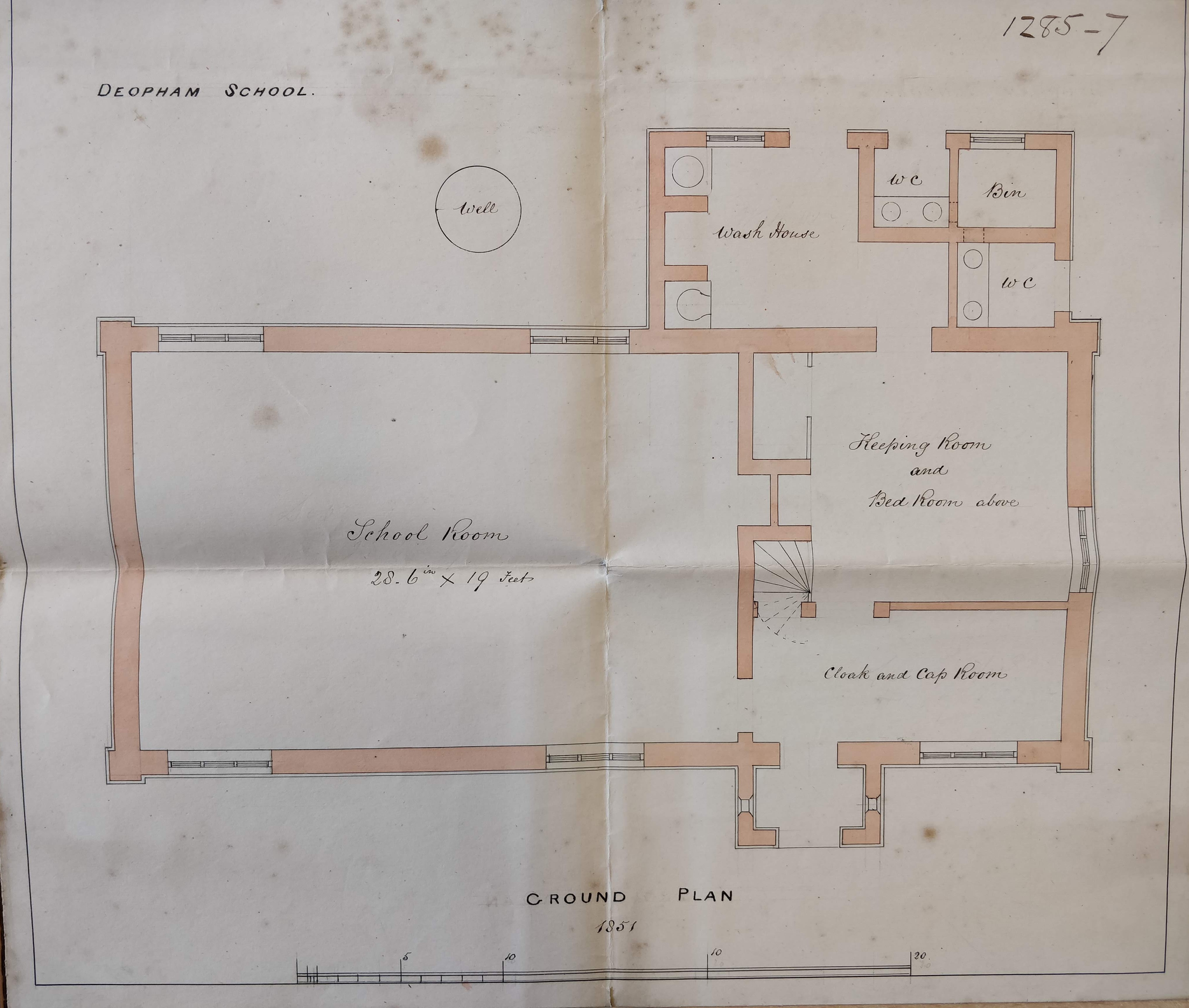
All rights reserved by Norfolk Record Office who hold the original, Ref P/BG/25/3
This plan shows the location: there is one narrow entrance, otherwise there is a fence/hedge along the road.
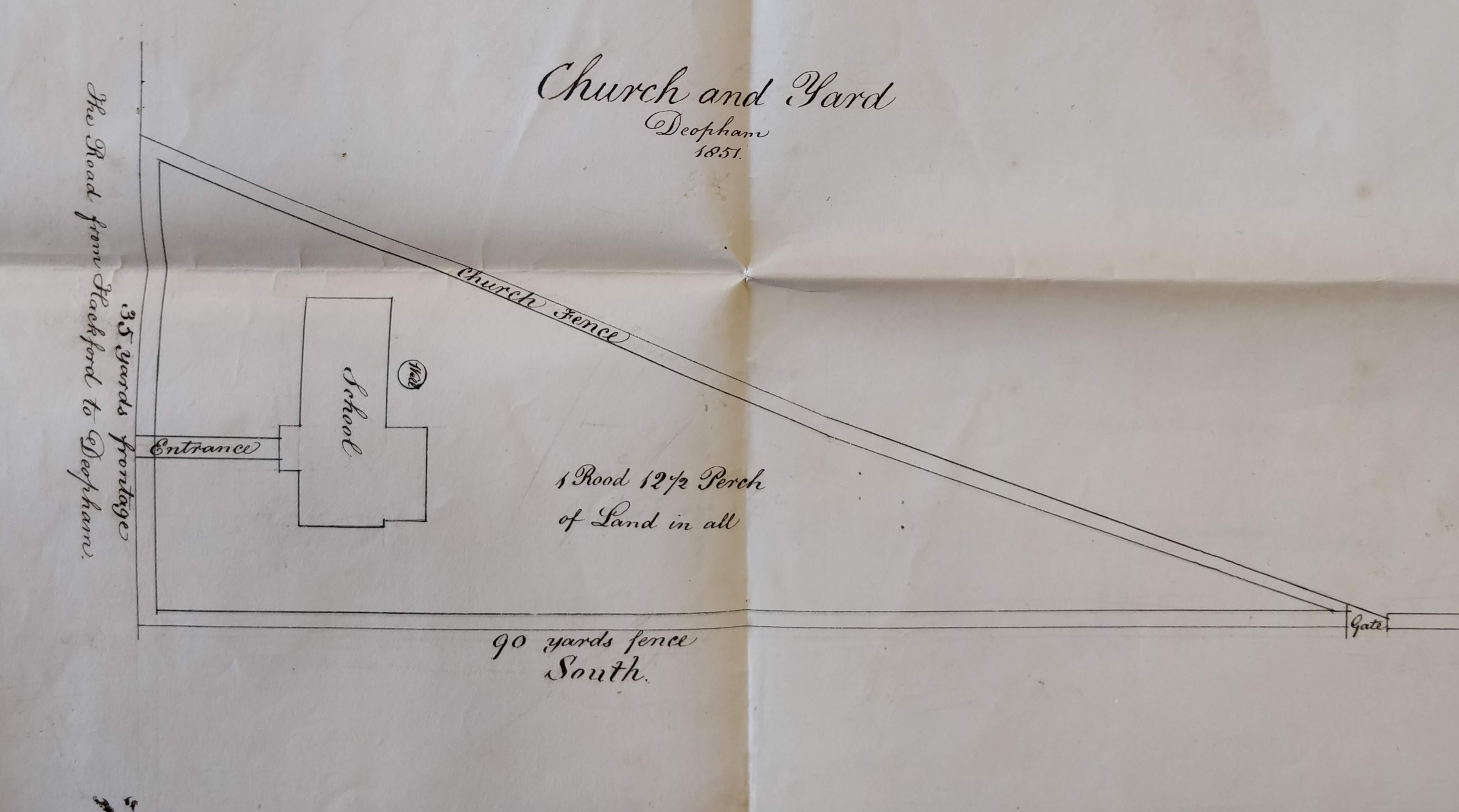
All rights reserved by Norfolk Record Office who hold the original, Ref P/BG/25/1
25/10/1855 Appeal for funds
Although now up and running, the location of funds for the school was a persistent problem. In 1855, following a visit to Deopham, the Archdeacon of Norwich, William Arundell Bouverie, wrote to the Rev. Arthur P. Stanley (at this time a canon at Canterbury) asking for support for the Rev. Turner‘s efforts. Mr. Bouverie said that he had only learned of the vicar’s financial difficulties from the churchwardens and the Lessee (“a respectable man who pays his quota of the £5”): these people “lamented the heavy charge which on account of the poverty of the parish falls on the Vicar”. The Archdeacon goes on to say that if an annual subscription or aid in some other form could be obtained for the school, the Dean & Chapter would “not only be giving a helping hand to a hard-working clergyman who deserves encouragement, but … doing good by manifesting an interest in the welfare of the parish with which you are by property connected”.
1861 New floor needed
One wonders what floor the schoolroom had for the first ten years!

All rights reserved by Norfolk Record Office who hold the original, Ref P/BG/25/4
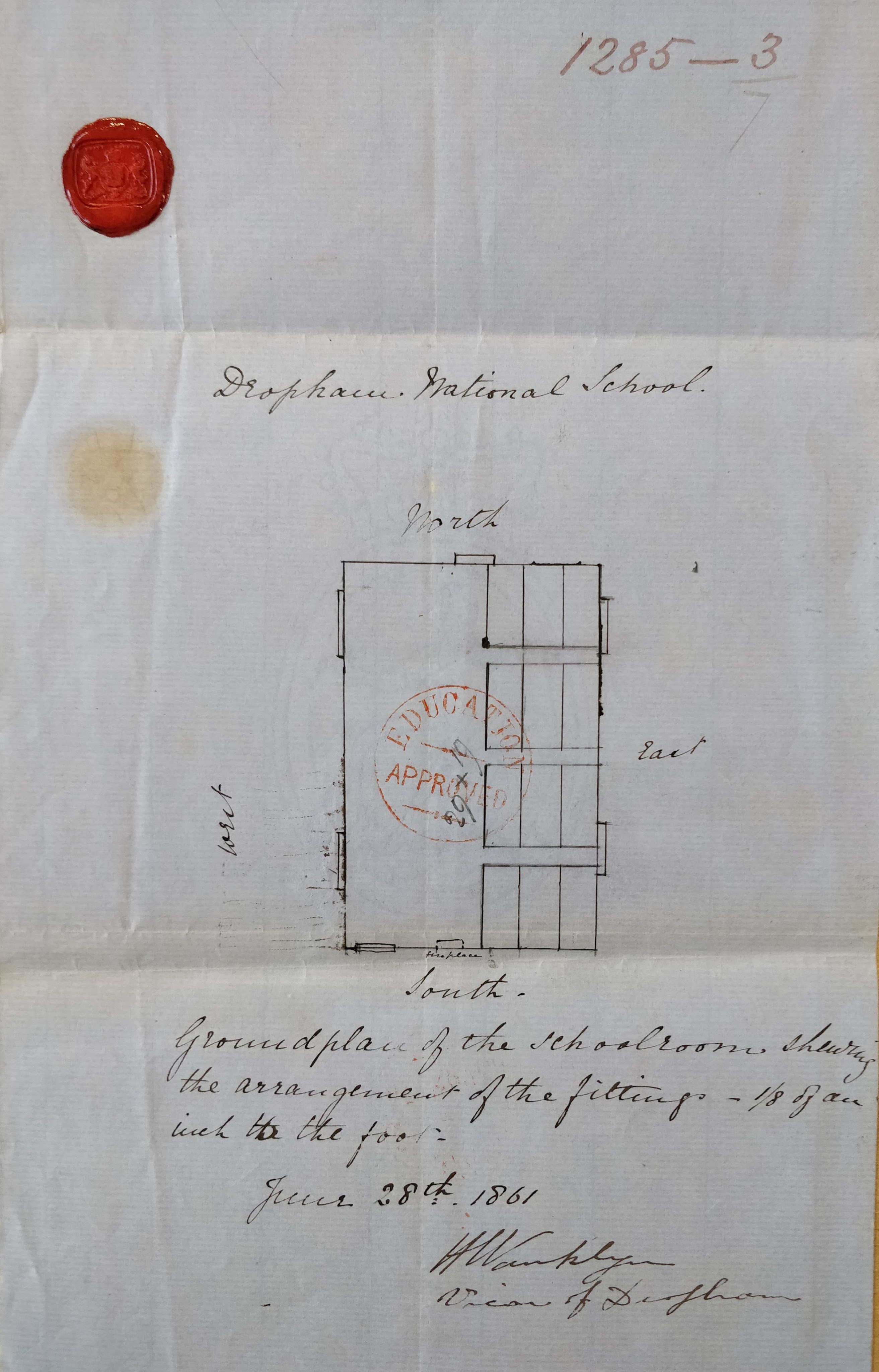
All rights reserved by Norfolk Record Office who hold the original, Ref P/BG/25/2
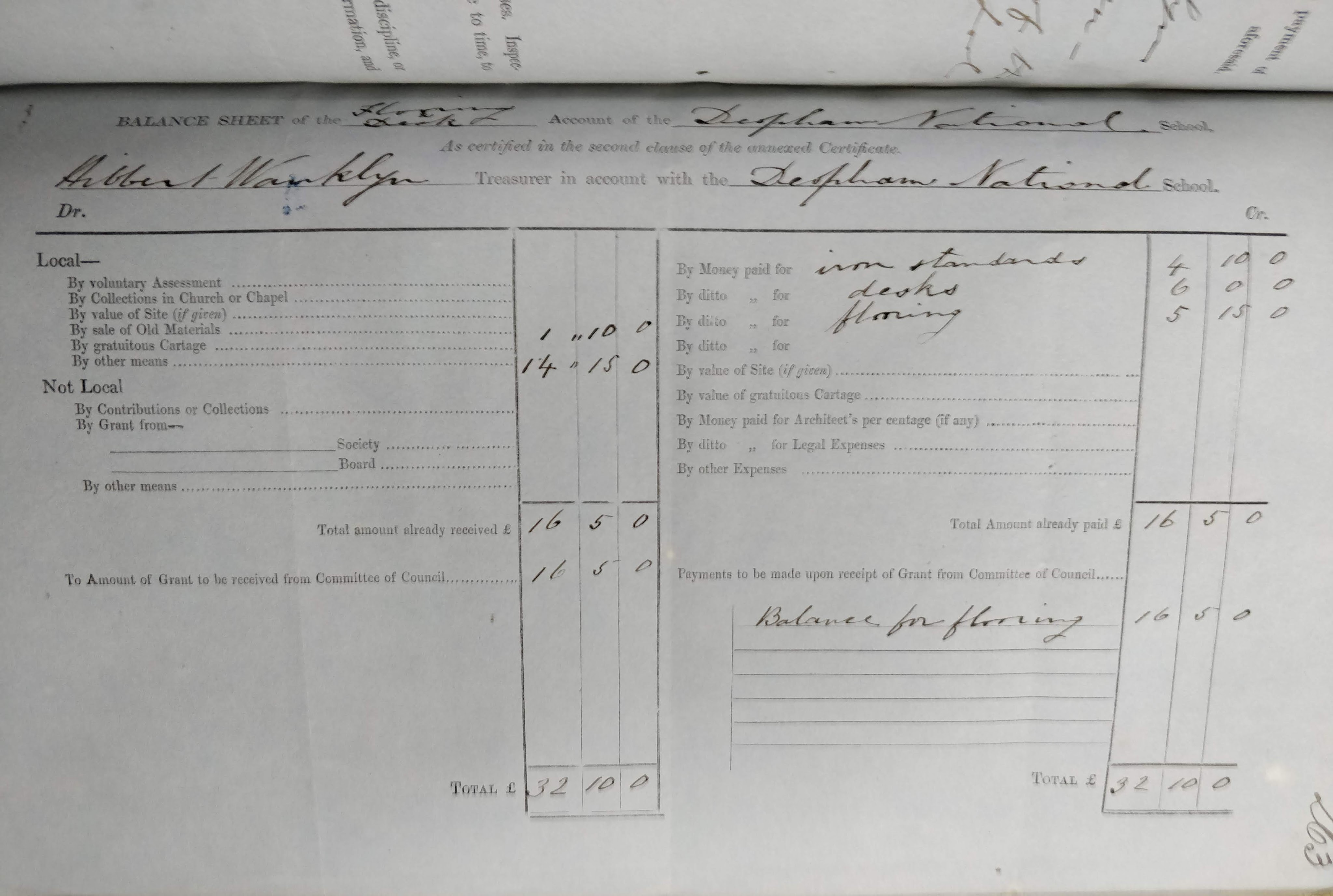

© National Archives, Kew
On July 18th 1861, the vicar, Hibbert Wanklyn, acknowledged receipt of £10 towards the cost of these works from the Dean & Chapter of Canterbury. In the accompanying letter, Wanklyn says of the stamp required to make a receipt official: “I have not one stamp, but if you require it perhaps you will be so very kind as to affix one”.

1862
On March 14th 1862 the vicar, the Rev. Hibbert Wanklyn, wrote to the Dean & Chapter of Canterbury to say that he had carried out the sanatory portion of the school works “and would now feel much obliged to you if you would be so kind as to favour me with the kind donation voted by the Dean and Chapter”. He goes on to explain that raising funds is particularly difficult because of problems with the church tower.
1886 Inspection
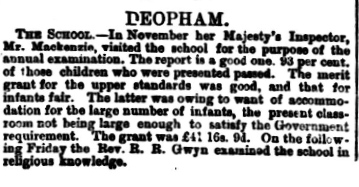
Norfolk News, 18th December 1886
27/6/1893 Entertainment given by schoolchildren

© FindMyPast
The 1903 return to Norfolk County Council Education Department recorded that the headteacher was Charles Rose Legge and the teacher was Elizabeth Maria Page.
(Records at NRO.)
October 1907 Appeal for government funding
An exchange of correspondence regarding government funding for the school in October 1907 is available here. A contribution of £5 was agreed.
31/3/1908 Closure of the school
The school was forced to close on March 31st 1908. There is information on the reasons for the closure here.
In 1864 the average attendance was 33 (White’s Directory, 1864). By 1888 & 1892 this had risen to 62 and in 1896 & 1900, was 67.
After closure, the village children eventually attended Hingham, Gt Ellingham, Morley St. Botolph & Wicklewood Schools for approximately one year until the Deopham Council School was opened in 1909.
The schoolroom was used as a meeting place after the school closure. There is more on the Hall here.
Public Elementary School or Council School (1909 – 1924)
10/5/1909 Opening of the tin school

All rights reserved by Norfolk Record Office who hold the original, Ref C/ED 83/1
This was a corrugated iron structure, built at Deopham Green in 1909. Although it was intended to be a temporary school, catering for up to 100 children, it was in use for exactly 15 years. The building became known by the villagers as the ‘Tin Tabernacle’.
The first entry in the Council School log book was dated 10th May 1909 with 33 children being enrolled. The staff at the time of opening were E. A. Miller and Miss G. M. Shanasy.
27/9/1909 New head
A J Whitehouse commenced duties as head teacher.
25/10/1909 Royal visit
The school was closed for the King’s visit to Norwich.
23/11/1909 School Inspector’s report
There are only two wall maps – one of Scotland and one of Ireland. As the geography of England is being taught at the present time, it is essential that a map of England should be supplied if the subject is to be taught intelligently.
The inspector carries on to recommend the supply of a map of the world, a musical instrument to enable “tuneful singing” and a few dictionaries.
23/11/1910 – Inspector’s Report
Owing to the closure of the old school and the dispersal of the children to different schools in the neighbourhood for a considerable time, the attendance became very low, and the attainments of the scholars, previously weak, were reduced to a state bordering on inefficiency. The present mistress has effected a gratifying change in a very short time.
24/7/1911 – Labour Exam
The school log book records: Hilda Gudrum, James Linstead, Frank Hurrell attended the Labour Exam this morning.
15/11/1911 Inspector’s Report
The Board would be glad to learn how soon it is proposed to replace these temporary premises by a suitable permanent building.
April 1913 – Diphtheria
The school log reports an outbreak of diphtheria amongst the pupils.
31/3/1915 Parish Meeting
A Parish Meeting on March 31st 1915 agreed the following resolution: “This meeting is of opinion that there are unsatisfactory conditions existing in the above school [i.e. the tin school] likely to cause a future decrease in the attendance. Therefore we call the attention of the Norfolk Education Committee and the Board of Education.” The Clerk was instructed to write to the separate authorities.
December 1917 More heating problems
Throughout the school’s temporary existence it was plagued with heating problems. The stoves either refused to light or classrooms were smoked out because of blocked chimneys. In December 1917 the log book entry read ‘Very cold this morning. Temperature of main room at 9 o’clock = 27° F. Ink frozen’.
11/1/1918 School buildings inspection
Mr Lambert Lack reported that:-
The temperature of the School Rooms is much effected by Weather conditions and this varies from 5 degrees below freezing to a healthy indoor temperature. On the Tuesday of this week the temperature was at 9 am 4 degrees below freezing although the fire was lighted at 7-30 am. At 9-30 am it was slightly higher 33 degrees but shortly again fell to 1 degree below freezing where it remained all day. On December the 19th and 20th it was below freezing.
The Norfolk Education Committee responded to this report as follows:-

All rights reserved by Norfolk Record Office who hold the original, Ref C/ED 83
The school attendances increased from 33 at the time of opening in 1909 to a maximum of 75 in 1922 and reduced to 67 at the time of closure in 1924.
School Masters / Mistresses:-
- 1909 – 1910 E. A. Miller
- 1910 – 1915 Mrs. H. Whitehouse
- 1915 – 1920 Mrs. Mildred New
- 1920 – 1922 A. N. Wheatly
- 1922 – 1924 Mrs. A. Hart
- ( M. A. Base, Miss Coe and Miss Atkins were supply teachers during 1923)
An article in issue 23 of the Norfolk Historic Buildings Group Newsletter explains that the
school was built by Boulton & Paul and first erected in Sheringham in the early 1900s to alleviate overcrowding in the Council-run school. Sheringham built a larger school in 1906, so the tin building was taken down and re-erected at Gaywood in 1907, where it served for only one year before being moved again, this time to Deopham in 1908/9, where it was opened as a “temporary school for 35 children”. Evidently the frequent disassembly and re-assembly had affected the structure, as Building Inspectors reported in 1911 that “the temporary wood and iron building seems to be badly constructed. The walls and floor are not draught proof; though the walls have been patched up recently. The “tortoise” stoves are very unsatisfactory, smoking so badly that the room is at best undesirable. The unprotected windows also cause draughts”. This was emphasised during another visit by Inspectors in March 1912 when “the temperature inside was 40°F (4.5°C) … with water dripping through the roof in many places”.
7/3/1924 More problems with heating
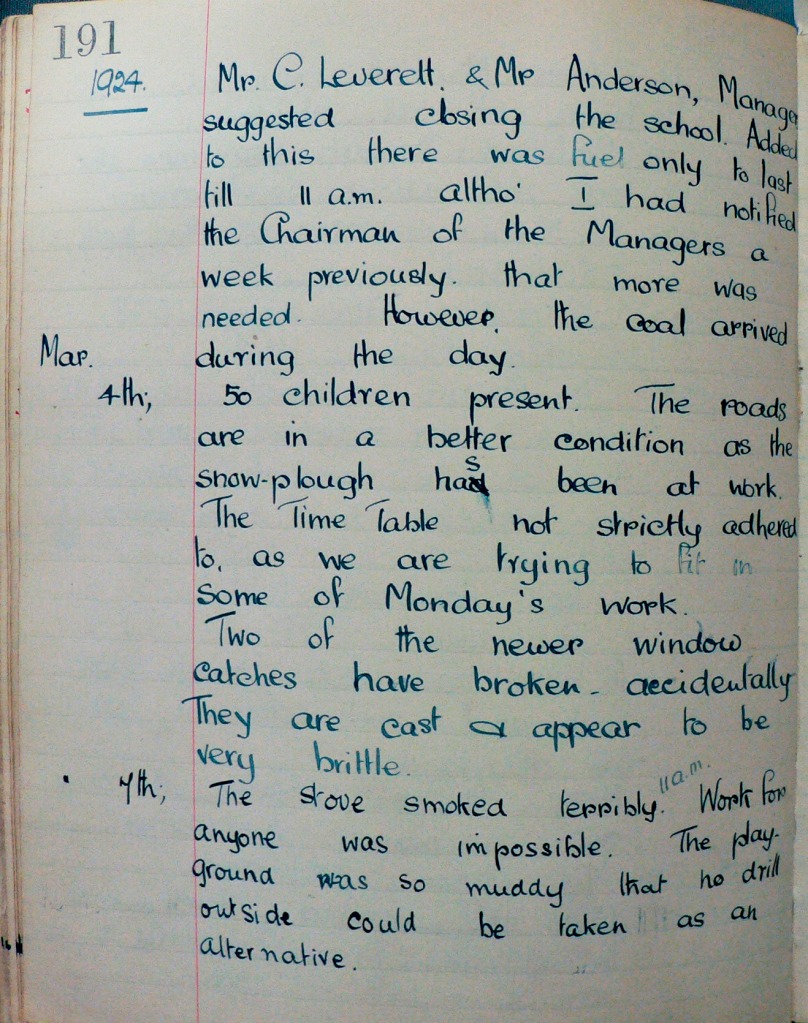
All rights reserved by Norfolk Record Office who hold the original, Ref C/ED 83/1
9/5/1924 Closure of the tin school
The school closed 9th May 1924. The log book entry for this day was, “ This is the last day in the old building. All the children have been cleaning & polishing (furnishing) furniture, preparatory to moving tomorrow.”
County Primary School (1924 – 1980)
9/3/1920 Education Committee resolves to build a new school

© National Archives, Kew
12/5/1924 New school opens

All rights reserved by Norfolk Record Office who hold the original, Ref C/ED 83
13/5/1924 Formal opening of the new school
This school was erected on Vicarage Road and was designed to educate up to 104 children. It was officially opened 13th May 1924 by Mr. H G Copeman (Chairman of the Education Committee). Over 100 parents and friends were present. The full report of this occasion can be read by pressing the following button:-
The head teacher at the time of opening was Mrs. A. Hart and she continued to be in charge until 1942.
1925 – Scarlet fever
The log book records the progress of scarlet fever across the school population during the last months of the year. By December, the attendance level had dropped to 17.8%.
4/9/1939 Outbreak of War

All rights reserved by Norfolk Record Office who hold the original, Ref C/ED 83/1
10/9/1939 Evacuees arrive
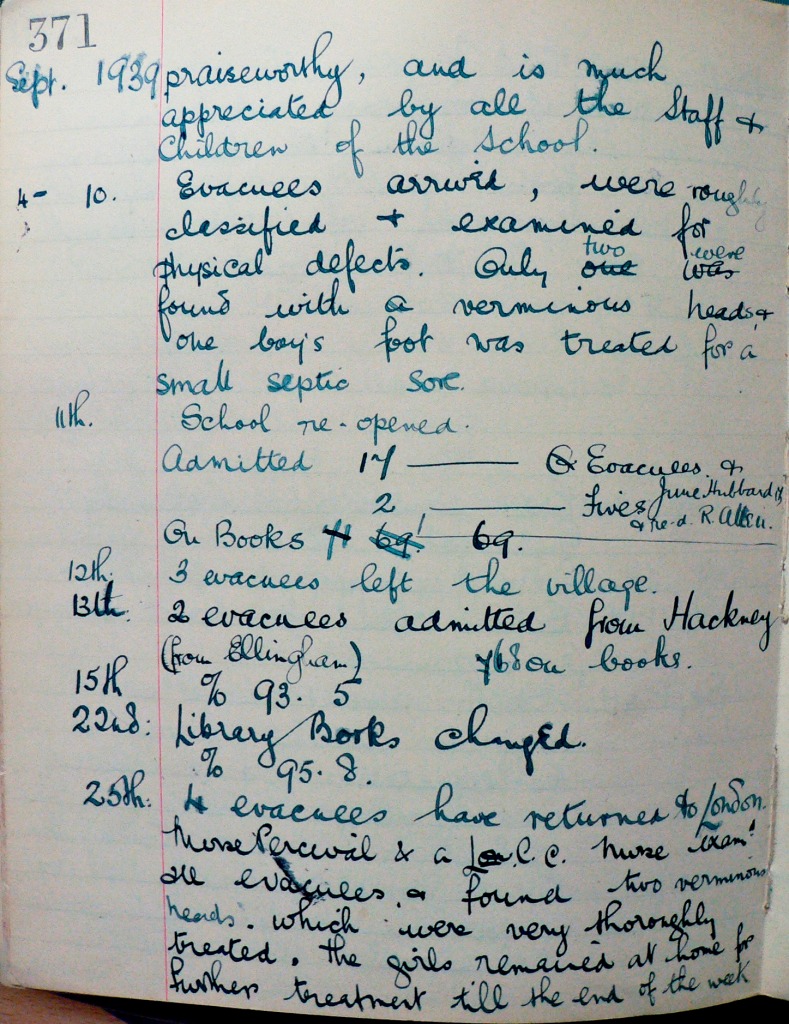
All rights reserved by Norfolk Record Office who hold the original, Ref C/ED 83/1
12/10/1942 New headteacher
Mrs. Bone started as head teacher on 12th October 1942. Mrs. Attewell was then in charge of the infants. She joined the school on the 1st May 1951, replacing Miss Coe, who had been at the school since its opening in 1924.
1/5/1951 New Infants teacher
Mrs. Attewell joined the school on the 1st May 1951 to be in charge of the infants. She replaced Miss Coe, who had been at the school since its opening in 1924.
5/2/1952 – Report by HM Inspectors
The following is an extract from the school log book (held in the Norfolk Record Office) dated 5th February 1952 :-
This is a County Primary School of 47 children who range in age from 4 to 14 year. Pupils are transferred to Wymondham Secondary Modern School at the age of 14.
The premises, which are in good condition and are well-kept, consist of three classrooms, adequate sanitary facilities and a small kitchen. The playground is paved and level and a playing field adjoining the school comes into use this year after its initial preparation. There are two separate areas of school garden with a tool shed. The gardening tools were seen to be in exemplary condition; the whole school impresses by its neatness and good order. An excellent mid-day meal is served from the kitchen and is taken by the majority of the children. The weekly supply of vegetables is at present kept in boxes in a cloakroom; a store shelf or container is necessary.
The school is arranged in three classes. The infants are taught by a Supplementary teacher who came to the school in 1951. The children in this class are receiving a sound initial training in the basic skills, and are forming good habits of work from the beginning. Adequate opportunities are given for movement and activity and appropriate broadcast lessons are being well used. The children are growing in confidence.
The mistress in charge of the junior class is qualified by a length of service. Her interest in music, dancing and nature study is making a valuable contribution to the life of the school. The junior class is grouped according to widely varying abilities; the work in general is not of a high standard. Good progress is being made in reading but the written work tends to be formal and lacking in finish. Schemes and records of work need to be revised and enlarged.
The older boys and girls are taught by the Head Mistress who was appointed in 1942. The work in this class is well planned and graded and allows full scope for individual development. There are at the same time valuable class activities, including the detailed study of a local farm. This study is giving rise to exercises in local geography and also to practical everyday arithmetic.
The children are given suitable responsibilities for various aspects of school life and they show a very commendable response to the demands of them. Their application to work is outstanding. The school is not able to send their older boys and girls to centres for Handicraft and Housecraft, but the Head Mistress has successfully provided comparative activities for the boys. These include light woodwork, gardening and cane-work. The possibility of enlarging the range of crafts and allied activities for the girls was fully discussed with the Head Mistress. The work in the basic subjects is for the most part realistic and reaches a satisfactory standard.
Phil Long, the founder of this site, recalls “When I moved up to the juniors, Mrs. Greenwood became my teacher. She joined the school 1st July 1954. My teacher in the seniors was Mrs. Bone and she was still head of the school at the time I left the village in 1962. My attendance at the school was from 1952 until 1959, after which I was then bused (courtesy of Semmence coaches) to Wymondham Secondary Modern.”.
25/7/1980 Closure of the school
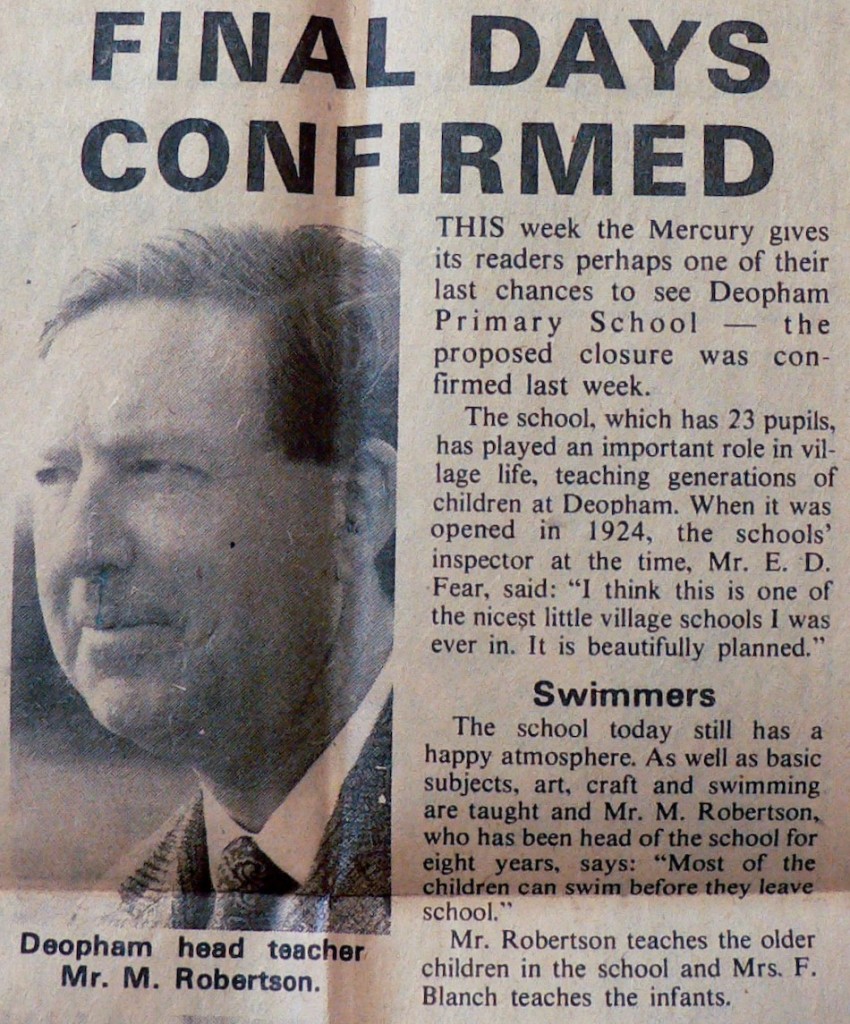
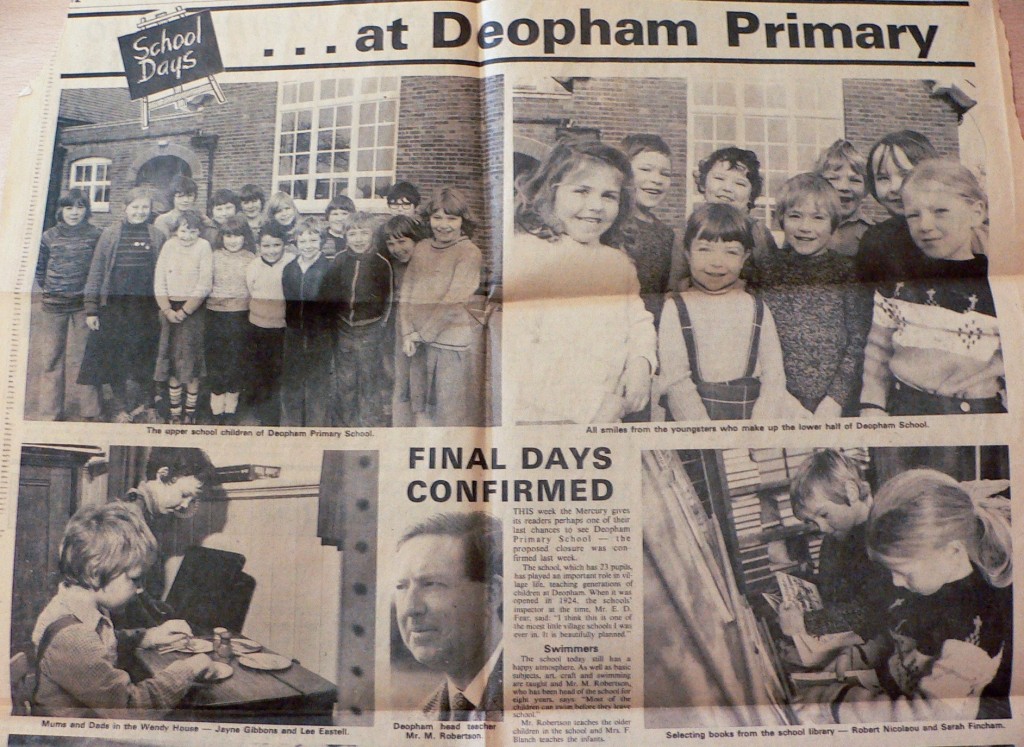
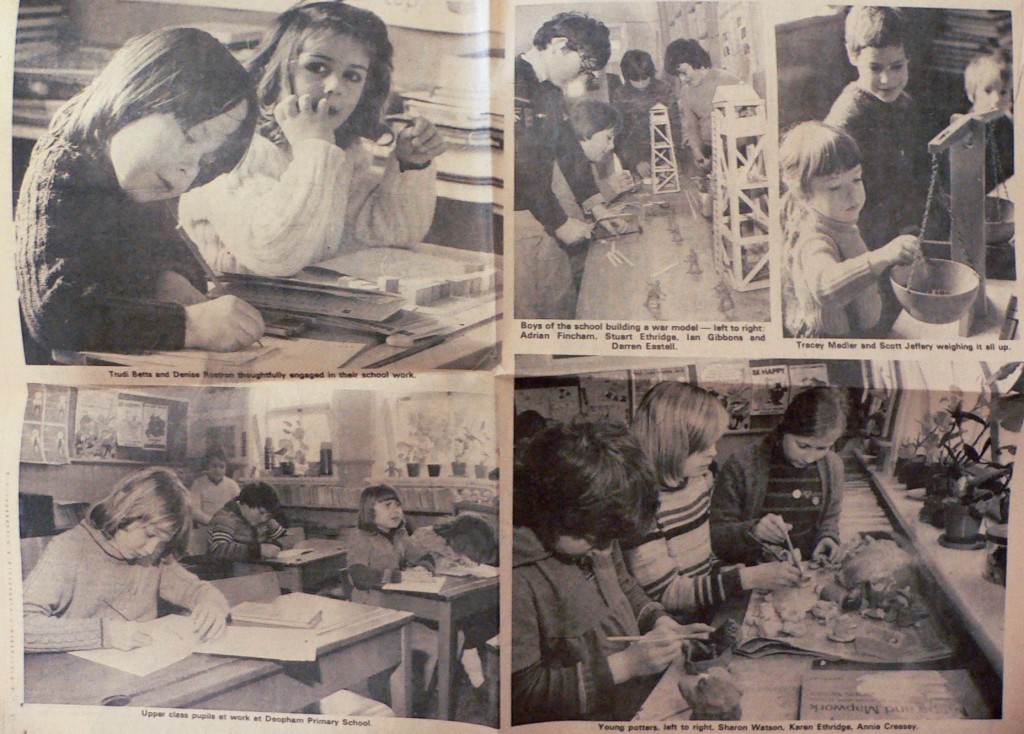
Thanks to Phil Long for supplying the above three newspaper images.

© FindMyPast
The head teacher at the time of the school’s closure was Mr. M. Robertson, who taught the older children; Mrs. F. Blanch was teaching the infants.
The last school in Deopham finally closed on 25th July 1980 with 23 children being transferred to other schools.
The following picture shows the school prior to it being sold in 1984:
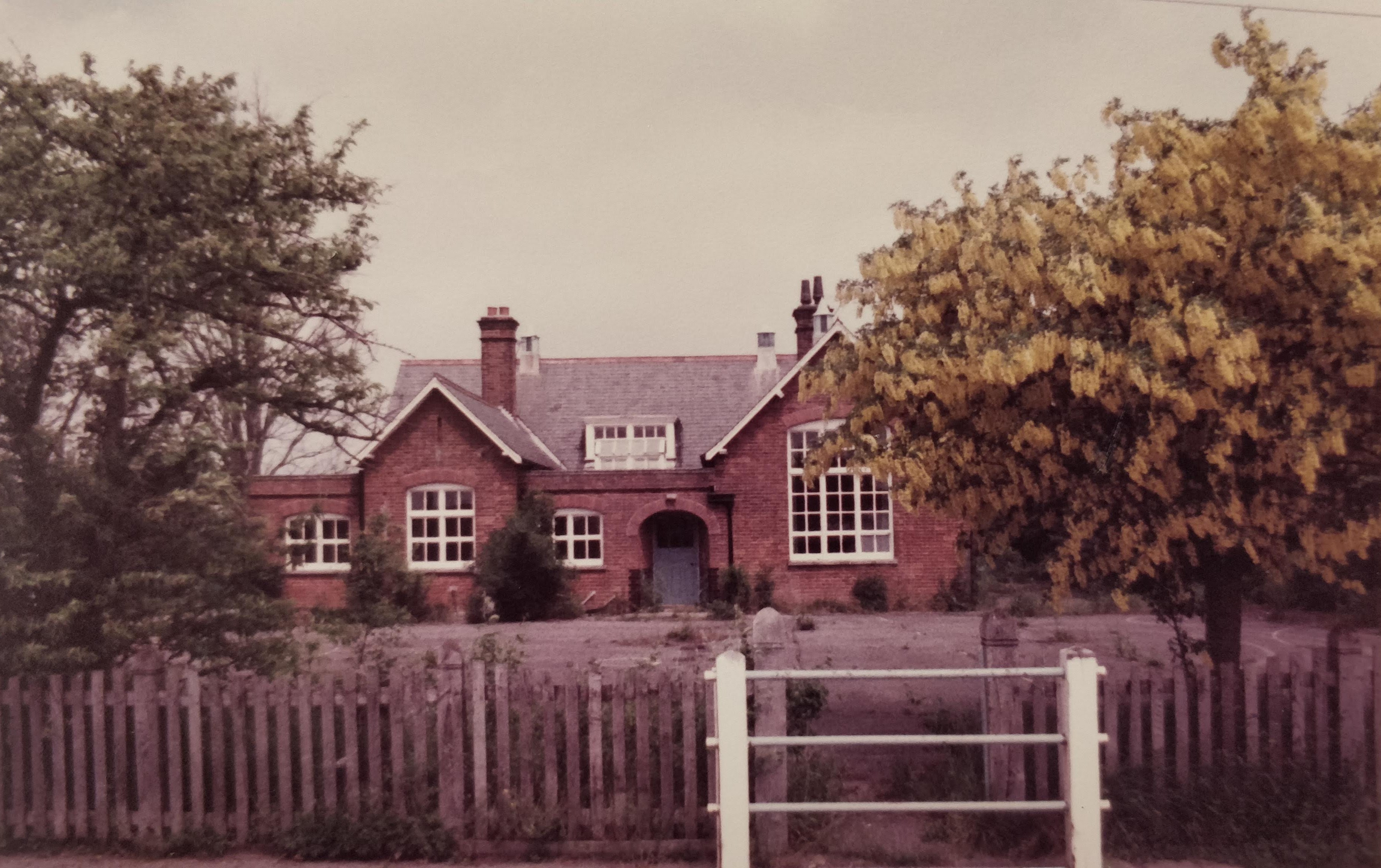
Photo: Irelands, Hall & Palmer.
There is a full copy of the 1984 sales particulars for the school here.
This photo shows the school in October 2022. It is now called Deopham House.
Photo: G. Sankey
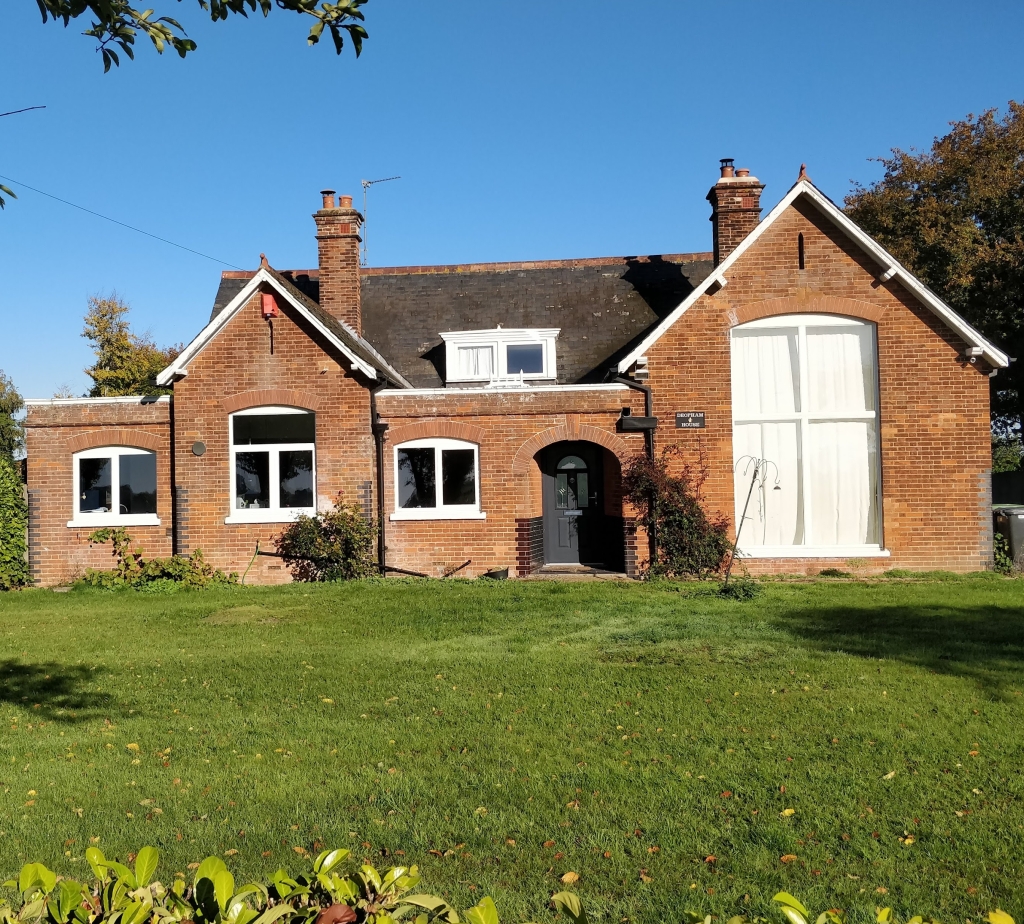
| Date | Change |
|---|---|
| 1/3/24 | 1886 Inspection |
| 4/11/23 | Bouverie letter |
| 2/11/23 | Link to founding of first school |
| 27/10/23 | Link to 1864 directory |
| 9/10/23 | Link to 1907 appeal for funding |
| 8/9/23 | Link to 1984 sales particulars |
| 30/8/22 | Published |